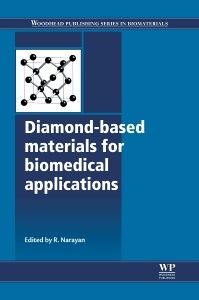Diamond-Based Materials for Biomedical Applications Woodhead Publishing Series in Biomaterials Series
Coordonnateur : Narayan Roger

Part one provides a clear introduction to diamond based materials for medical applications. Functionalization of diamond particles and surfaces is discussed, followed by biotribology and biological behaviour of nanocrystalline diamond coatings, and blood compatibility of diamond-like carbon coatings. Part two then goes on to review biomedical applications of diamond based materials, beginning with nanostructured diamond coatings for orthopaedic applications. Topics explored include ultrananocrystalline diamond for neural and ophthalmological applications, nanodiamonds for drug delivery systems, and diamond nucleation and seeding techniques for tissue regeneration. Finally, the book concludes with a discussion of diamond materials for microfluidic devices.
With its distinguished editors and international team of expert contributors, Diamond-based materials for biomedical applications is an authoritative guide for all materials scientists, researchers, medical practitioners and academics investigating the properties and uses of diamond based materials in the biomedical environment.
Contributor contact details
Woodhead Publishing Series in Biomaterials
Part I: Introduction to diamond-based materials for medical applications
Chapter 1: Introduction to medical applications of diamond particles and surfaces
Abstract:
1.1 Introduction
1.2 Growth of synthetic diamond
1.3 Diamond-based medical devices
1.4 Functionalization of nanodiamond and nanocrystalline diamond
1.5 Drug delivery using nanodiamond
1.6 Imaging with nanodiamond
1.7 Conclusion
1.8 Acknowledgments
Chapter 2: Functionalization of diamond surfaces for medical applications
Abstract:
2.1 Introduction
2.2 Electrochemical reduction of aryldiazonium salts
2.3 Photochemical modification
2.4 Preparation of amine-terminated diamond surfaces
2.5 Preparation of oxygen-terminated diamond surfaces
2.6 Conclusion and future trends
Chapter 3: Biotribology and biological behaviour of nanocrystalline diamond (NCD) coatings for medical applications
Abstract:
3.1 Introduction to nanocrystalline diamond (NCD)
3.2 NCD-coated silicon nitride ceramics as new materials for joint replacement
3.3 Growth and characterization of NCD films deposited on Si3N4 substrates
3.4 Biotribology of NCD coatings
3.5 Biological behaviour of NCD-coated Si3N4 ceramics
Chapter 4: Blood compatibility of diamond-like carbon (DLC) coatings
Abstract:
4.1 Introduction
4.2 Diamond-like carbon (DLC) structure, properties and applications
4.3 Deposition techniques for DLC films
4.4 DLC blood compatibility
4.5 Modified DLC films
4.6 Biomedical applications of DLC coatings
4.7 Conclusion and future trends
Part II: Biomedical applications of diamond-based materials
Chapter 5: Nanostructured diamond coatings for orthopaedic applications
Abstract:
5.1 Introduction
5.2 Ultra-hard carbon coatings
5.3 Wear measurements for ceramic-based orthopaedic implants
5.4 Mesenchymal stem cells derived from bone marrow and their interactions with nanostructured diamond surfaces
5.5 Macrophage cell interactions to diamond wear debris
5.6 In vivo evaluation of nanostructured diamond surfaces
5.7 Future trends
5.8 Acknowledgements
Chapter 6: Ultrananocrystalline diamond (UNCD) films for ophthalmological applications
Abstract:
6.1 Introduction
6.2 The use of ultrananocrystalline diamond (UNCD) films as coatings in the restoration of sight in people blinded by degenerated photoreceptors
6.3 The use of UNCD films in the treatment of glaucoma
6.4 Integrated magnet/superparamagnetic nanoparticles interacting system for new treatment of retina detachment
6.5 Conclusions
6.6 Acknowledgments
Chapter 7: Ultrananocrystalline diamond (UNCD) for neural applications
Abstract:
7.1 Introduction
7.2 Mechanism aspects of ultrananocrystalline diamond (UNCD)/neural cell interactions
7.3 Methods of guiding neurons
7.4 Neural and retinal prostheses
Chapter 8: Nanodiamonds for drug delivery systems
Abstract:
8.1 Introduction
8.2 Surface modification of diamond nanoparticles for drug delivery and targeting
8.3 Development of nanodiamond-based drug delivery for proteins
8.4 Development of nanodiamond-based drug delivery for genes
8.5 Development of nanodiamond-based drug delivery for low molecular weight therapeutic agents
8.6 Biocompatibility, biodistribution and biological fate of nanodiamonds
8.7 Conclusions
Chapter 9: Diamond nucleation and seeding techniques for tissue regeneration
Abstract:
9.1 Introduction
9.2 Diamond nucleation
9.3 Methods for diamond nucleation and seeding
9.4 Bias enhanced nucleation in hot filament chemical vapour deposition
9.5 Ultrasonic seeding
9.6 Seeding using a polymer composite
9.7 Spontaneous nucleation
9.8 Biological and tissue engineering applications
Chapter 10: Diamond materials for microfluidic devices
Abstract:
10.1 Introduction
10.2 Materials for the manufacture of microfluidic devices
10.3 Diamond microfluidic devices
10.4 Conclusions and future trends
10.5 Acknowledgments
Index
- Presents the fundamental principles and novel applications of this versatile material
- Discusses the functionalization of diamond particles and surfaces, biotribology and biological behaviour of nanocrystalinediamond coatings and blood compatibility of diamond-like carbon coatings
- Reviews nanostructured diamond coatings for orthopaedic coatings
Date de parution : 03-2013
Ouvrage de 296 p.
15.5x23.3 cm



